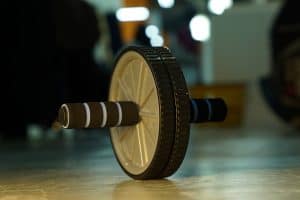If you go to your gym and all you do is 4 sets of 10.
3 – 4 exercises, 3 times a week.
And you expect to grow … You are delusional!
Whether you’re male or female, beginner or veteran.
Training to failure is essential for muscle building. Period.
This is not just some advice from a gym junkie or even a pro-card bodybuilder.
This has been scientifically proven in numerous studies.
So, what are the benefits and the potential downfalls of training to failure? And how to train to failure?
Before addressing these questions and go into further detail, let’s define what failure is in weight lifting.
What is Training to Failure?
I see many lifters confuse failure with beyond failure. There is a big difference.
Training to Failure:
Is defined as the point in your set where you cannot do any more concentric repetitions with the correct form (correct form is not to be confused with strict form, leaving room for challenging reps).
Any repetition after that point would require assistance from either momentum/cheating, spotter, dropping the weight, or pause.
This is called beyond failure (or some call it True Failure).
For example, say you are doing side lateral raises for side shoulders with 25-pound dumbbells.
You reached 10 repetitions with exhaustion and a good form but you couldn’t do more reps without assistance. The rep number 11 and beyond is where you start leaning forward and get sizable momentum from your hips to help push the weight (i.e. sloppy form).
It is safe to assume that rep 10 is where you reached “failure” and rep 11 and after is “beyond failure”.
Whether it's failure or beyond failure, the main takeaway here is that the last few repetitions matter more than the first few ones.
While the science is far from settled, many studies showed that training to failure increases muscle growth by up to 13% and normal training by only 4%. This means that the last few sets leading up to failure are more important to muscle hypertrophy than the first reps.
Training to failure increases the number of muscular fibers torn down during the workout. This means that if adequate nutrition is available (from the pre-workout meal, intra-workout, and post-workout), especially amino acids and carbohydrates, more fibers are repaired and built due to the increase in muscle protein synthesis. Which means more muscle gains and growth.
Training to failure was also shown to increase the production of growth hormone levels immediately and up to 30 minutes after the training set.
Other studies, however, showed that failure and beyond failure training may not be effective for muscle growth, or even worse hindering gains. From a practical side of view, almost all professional bodybuilders, lifters, and athletes tend to disagree with these findings.
Should you Train to Failure on All Exercises?
Technically speaking, you should go to failure in all exercises as it stimulates muscle growth.
However, for safety purposes, you should not attempt to train to failure in all free barbell exercises that require assistance from external sources (spotter).
These exercises are free barbell bench press (flat, incline, or decline), free barbell squat, deadlift, and- to a lesser extent- shoulder military presses with a free barbell.
As a piece of safety advice always leave at least one rep in the tank before reaching failure in the above exercises as serious injuries might happen.
But that does not mean the sets should be easy! They should be difficult and challenging.
Let’s take the bench press with the free barbell, as an example. Say, you did 9 reps and struggled with the rep number 10. It’s advised not to proceed with more reps.
As a rule of thumb: if you are 1% in doubt whether or not you should do an additional rep, do not do it!
I’ve seen many incidents of bars crushing the bones of lifters and numerous injuries from pec tears to lower back strain (especially from the squat or deadlift), to shoulder impingement just from not backing off on doing an additional set.
Excluding the free barbell, It is much safer to reach failure and even beyond failure using machines or dumbbells because you can drop them immediately once you reach muscle fatigue.

How to Train to Failure?
It is usually recommended to go to failure on the last one or two sets of each exercise except when using the free barbell.
And go beyond failure on only two or three sets for the entire workout.
Beyond failure should be incorporated anywhere from once every other week to once a month for each muscle group depending on your training goals and stage.
Here is an example of a chest workout:
1- Flat barbell bench press – 5 sets. No failure.
2- Incline dumbbell bench press – 5 sets. Go to failure on the last two sets.
3- Dips – 5 sets. Go to failure on set # 4. On set #5, go beyond failure:
- drop set – if you’re using weighted dips, or
- cluster set: rest for 10 seconds before doing another 6-4 reps, then rest another 10 seconds and do 4-3 reps using the same weight.
4- Machine flyers – 5 sets. On the last two sets, go to failure.
5- Cable crossover – 5 sets. On the last two sets, go beyond failure:
- 3-drop sets: say you did 10 reps, drop the weight by 20% and immediately do another 10-12, drop the weight again by 20%, and do 12-10 reps.
So we have a total of 5 sets of failure and 3 sets of beyond failure.
Of course, you should incorporate more beyond failure sets if you’re workout bigger muscle groups like legs, particularly on the leg press machine, leg extension, leg curls, and calves.
The Downside of Training to Failure
Ok, we know the benefits of training to failure and beyond failure to stimulating muscle growth and hypertrophy. Are there any cons?
Sure there are a few when done excessively:
1
Training to Failure Sacrifices volume.
Volume is the number 1 key to hypertrophy. If you are going to train more sets to failure, you have no choice but to go lower on the total number of exercises and the overall sets.
2
Training to Failure Could Fatigure the Central Nervous system
Going to failure and beyond failure is conducive to less recovery and, perhaps, central nervous fatigue. That’s when you can’t progressively lift heavier weights.
3
Training to Failure Increases stress.
Not only going to failure and beyond might lead to less recovery, but it also leads to higher levels of cortisol. This is a catabolic stress hormone that increases muscle protein breakdown and, hence, hinders your muscle growth.













